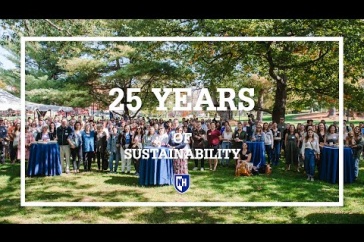
Visitors to downtown Durham this spring might have noticed students sporting an unusual accessory: a sticker with a yellow droplet on it proclaiming "I donated my nitrogen."
No personal sacrifice was involved in the donation; rather, students did something they likely needed to do, badly. They patronized a custom-built Porta-Potty dubbed the Peebus.
Officially called Durham Urine Diversion & Recycle, the effort was the senior capstone project for three environmental engineering students and a business major, who solicited their well-hydrated fellow students to divert nitrogen-rich urine from Durham's wastewater treatment plant and onto actual plants, where it could be used as fertilizer. Along the way, the students—environmental engineering majors Taylor Walter '14, Alyson Packhem '14, and Adam Carignan '14, and business major Liz McCrary '14—educated their classmates to think beyond the flush.
"Everybody pees and nobody thinks about where your pee goes," says Walter. In fact, it goes to the town's wastewater treatment plant, where much of its nitrogen must be filtered out before it enters the Great Bay estuary. Yet that same nitrogen makes urine a very productive fertilizer; a secondary goal of the project involved exploring the use of pasteurized urine as a fertilizer for hay crops.
Over four weekend nights in March and April, the students parked their Peebus at several well-traveled campus crossroads to solicit "donations." The response was overwhelmingly positive, with nearly 400 students participating. The stickers generated buzz as they became the spring's must-have fashion accessory in Durham bars.
The Peebus students worked closely with Durham town engineer David Cedarholm '94G, who initiated the project after noticing spikes in nitrogen entering the plant on weekend evenings. He approached his former professor Nancy Kinner, professor of environmental engineering, who in turn pitched the project to the students.
"People don't realize that urine is actually a valuable resource," says Cedarholm, who drew inspiration for this project from the Rich Earth Institute of Brattleboro, Vt., a larger-scale urine reuse project.
In the end, the students fell far short of collecting the 1,000 gallons needed to fertilize one acre of hay crop, so they shifted their goal toward education, helping a wide audience get beyond the "ick factor" and understand the complex environmental issues behind the flush. "We did the donors a service, they did us a service, so it's a win-win. And they learned something," said Walter.
Plus, she added, "they got a sticker."
?
Originally published by:
UNH Magazine, Spring 2014 Issue
?
-
Written By:
Beth Potier | UNH Marketing | beth.potier@unh.edu | 2-1566




















































